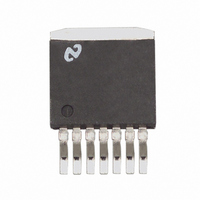LM2593HVS-5.0/NOPB National Semiconductor, LM2593HVS-5.0/NOPB Datasheet - Page 15

LM2593HVS-5.0/NOPB
Manufacturer Part Number
LM2593HVS-5.0/NOPB
Description
IC REG SW 5V 2A STP DN TO-263-7
Manufacturer
National Semiconductor
Series
SIMPLE SWITCHER®r
Type
Step-Down (Buck)r
Datasheet
1.LM2593HVS-ADJNOPB.pdf
(21 pages)
Specifications of LM2593HVS-5.0/NOPB
Internal Switch(s)
Yes
Synchronous Rectifier
No
Number Of Outputs
1
Voltage - Output
5V
Current - Output
2A
Frequency - Switching
150kHz
Voltage - Input
4.5 ~ 60 V
Operating Temperature
-40°C ~ 125°C
Mounting Type
Surface Mount
Package / Case
D²Pak, TO-263 (7 leads + tab)
Primary Input Voltage
12V
No. Of Outputs
1
Output Voltage
5V
Output Current
2A
No. Of Pins
7
Operating Temperature Range
-40°C To +125°C
Msl
MSL 3 - 168 Hours
Filter Terminals
SMD
Rohs Compliant
Yes
For Use With
LM2593HVEVAL - BOARD EVALUATION LM2593
Lead Free Status / RoHS Status
Lead free / RoHS Compliant
Power - Output
-
Other names
*LM2593HVS-5.0
*LM2593HVS-5.0/NOPB
LM2593HVS-5.0
*LM2593HVS-5.0/NOPB
LM2593HVS-5.0
Available stocks
Company
Part Number
Manufacturer
Quantity
Price
Part Number:
LM2593HVS-5.0/NOPB
Manufacturer:
NS/国半
Quantity:
20 000
Application Information
Therefore, looking at Figure 4 we quick-select a 47µH/2A
inductor (designed for 150 kHz operation) for this applica-
tion.
2. We should confirm that it is rated to handle 200 µJ (see
Figure 6 ) by the procedure shown in AN-1197 and that the
losses are acceptable. (If the DC Input voltage had been
greater than 40V we would need to consider e
Example 2 above).
This completes the simplified inductor selection procedure.
For more general applications and better optimization, the
designer should refer to AN-1197. Figure 8 provides helpful
contact information on suggested Inductor manufacturers
who may be able to recommend suitable parts, if the require-
ments are known.
FEEDFORWARD CAPACITOR
(Adjustable Output Voltage Version)
C
Figure 1 is used when the output voltage is greater than 10V
or when C
compensation to the feedback loop and increases the phase
margin for better loop stability.
If the output voltage ripple is large (
output voltage), this ripple can be coupled to the feedback
pin through the feedforward capacitor and cause the error
comparator to trigger the error flag. In this situation, adding a
resistor, R
proximately 3 times R1, will attenuate the ripple voltage at
the feedback pin.
INPUT CAPACITOR
C
needed between the input pin and ground pin. It must be
located near the regulator using short leads. This capacitor
prevents large voltage transients from appearing at the in-
put, and provides the instantaneous current needed each
time the switch turns on.
The important parameters for the Input capacitor are the
voltage rating and the RMS current rating. Because of the
relatively high RMS currents flowing in a buck regulator’s
FF
IN
— A low ESR aluminum or tantalum bypass capacitor is
- A Feedforward Capacitor C
OUT
FF
, in series with the feedforward capacitor, ap-
has a very low ESR. This capacitor adds lead
FF
, shown across R2 in
>
5% of the nominal
(Continued)
CLIM
as in
15
input capacitor, this capacitor should be chosen for its RMS
current rating rather than its capacitance or voltage ratings,
although the capacitance value and voltage rating are di-
rectly related to the RMS current rating. The voltage rating of
the capacitor and its RMS ripple current capability must
never be exceeded.
OUTPUT CAPACITOR
C
and provide regulator loop stability. Low impedance or low
ESR Electrolytic or solid tantalum capacitors designed for
switching regulator applications must be used. When select-
ing an output capacitor, the important capacitor parameters
are; the 100 kHz Equivalent Series Resistance (ESR), the
RMS ripple current rating, voltage rating, and capacitance
value. For the output capacitor, the ESR value is the most
important parameter. The ESR should generally not be less
than 100 m or there will be loop instability. If the ESR is too
large, efficiency and output voltage ripple are effected. So
ESR must be chosen carefully.
CATCH DIODE
Buck regulators require a diode to provide a return path for
the inductor current when the switch turns off. This must be
a fast diode and must be located close to the LM2593HV
using short leads and short printed circuit traces.
Because of their very fast switching speed and low forward
voltage drop, Schottky diodes provide the best performance,
especially in low output voltage applications (5V and lower).
Ultra-fast recovery, or High-Efficiency rectifiers are also a
good choice, but some types with an abrupt turnoff charac-
teristic may cause instability or EMI problems. Ultra-fast
recovery diodes typically have reverse recovery times of 50
ns or less. The diode must be chosen for its average/RMS
current rating and maximum voltage rating. The voltage
rating of the diode must be greater than the DC input voltage
(not the output voltage).
SHUTDOWN /SOFT-START
This reduction in start up current is useful in situations where
the input power source is limited in the amount of current it
can deliver. In some applications Soft-start can be used to
replace undervoltage lockout or delayed startup functions.
If a very slow output voltage ramp is desired, the Soft-start
capacitor can be made much larger. Many seconds or even
minutes are possible.
If only the shutdown feature is needed, the Soft-start capaci-
tor can be eliminated.
OUT
— An output capacitor is required to filter the output
www.national.com













